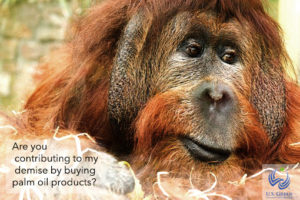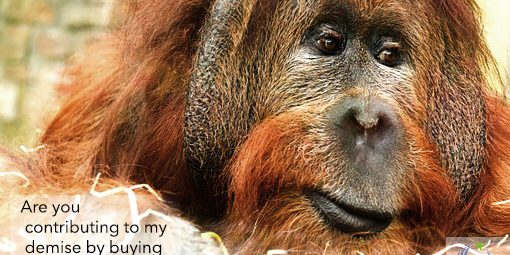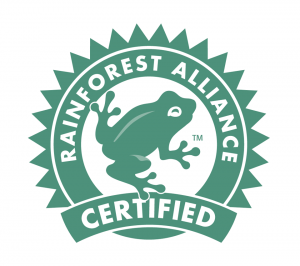By: Kimberly White
Is this dangerous ingredient lurking in your pantry? The ingredient to which I’m referring is palm oil. While it may not sound threatening to you, it is to the animals of the rainforest. Palm oil by itself is just a vegetable oil which is derived from the oil palm tree. It’s not the palm oil that is harmful to rainforest wildlife, it is the methods used to obtain it.
Tips:
- Check the ingredients list for palm oil! Sometimes it can appear under a different name like vegetable oil, palmitic acid, or palmate. If you’re unsure if an ingredient is palm oil disguised, look it up. Various websites like World Wildlife Fund have posted lists of the alternative names of palm oil.
- While shopping, look for products that bear the ‘Rainforest Alliance Certification’ seal. These products have been sourced from sustainable farms and forests. A guilt-free buy!
- Look for RSPO or Green Palm labels. These labels indicate that that the palm oil used was produced in a responsible and sustainable way.
- If you’re unsure, contact the company in question! Many companies have help lines or e-mail addresses in which you can reach them.
- Do a web search! Many websites, such as Rainforest Alliance, list products which are sustainably sourced. This can help you make your shopping list ahead of time.
Palm oil has become one of the most widely used products because it has a high crop yield and is the cheapest to grow. Unfortunately, with palm oil becoming so vastly used, it has become the source of destruction for rainforests and the creatures who dwell there.
According to Rainforest Rescue, a nonprofit organization working to save the rainforests, 90% of the world’s palm oil is being produced  in Malaysia and Indonesia. Currently, palm oil plantations are covering over 22 million acres in Indonesia alone. That is roughly the size of the state of Maine! It is projected to nearly triple in size by 2025.
in Malaysia and Indonesia. Currently, palm oil plantations are covering over 22 million acres in Indonesia alone. That is roughly the size of the state of Maine! It is projected to nearly triple in size by 2025.
- 90% of the world’s palm oil is produced in Malaysia and Indonesia.
- Palm oil plantations cover over 22 million acres in Indonesia, that’s roughly the size of the state of Maine!
- By 2025, the area palm oil plantations use will triple in size.
In 2007, the United Nations Environmental Programme (UNEP) stated that by 2022, 98% of the rainforests worldwide will have been destroyed.
Now, what does this have to do with orangutans? Orangutans are dependent upon the contiguous forests for shelter and food. With the palm oil plantations taking up more and more of their habitat, orangutans often find themselves lost on the plantations. Once they’ve wandered onto the plantation, they are treated as pests. The Centre for Orangutan Protection has reported that in 2006, 1,500 orangutans were beaten to death by palm oil plantation workers. Sadly, these practices continue today.
The Orangutan Foundation International, founded by renowned scientist and conservationist Dr. Birute Galdikas, writes, “The main threat to the survival of orangutan populations in the wild is the massive expansion of palm oil plantations in Borneo and Sumatra.”
Orangutans aren’t the only species being affected by the palm oil industry. The Sumatran elephant and Bornean pygmy elephant, both subspecies of the Asian elephant, have been impacted due to palm oil. According to World Wildlife Fund, the Sumatran elephant is listed by the International Union for Conservation of Nature (IUCN) as critically endangered. Much of their habitat is being illegally torn down for palm oil production. It is estimated that there are fewer than 3,000 left in the wild. The Bornean pygmy elephant has also suffered habitat loss due to illegal palm oil production, currently there are only about 1,500 left in Borneo.
- Fewer than 3,000 Sumatran elephants left in the wild.
- 1,500 Bornean pygmy elephants remain after habitat loss.
On the continued list of pachyderms affected by the palm oil industry is the Sum
atran rhino. The Sumatran rhino, the smallest of the rhinoceros family, already deals with an unstable population due to hunting. This rare creature is now being faced with habitat destruction due to palm oil plantations taking over its homeland. The IUCN Red List records that, as of 2008, there are approximately 2,575 remaining, placing them on the critically endangered list.
- Sumatran rhinos have been placed on the critically endangered list.
- Only 2,575 remain in the wild.
There’s a member of the feline variety at risk, too; the Sumatran tiger. The IUCN lists that the major threat to Sumatran tigers is loss of habitat “… due to the expansion of oil palm plantations and planting of Acacia plantations.” There are fewer than 400 of these majestic cats left in Sumatra. World Wildlife Fund reports that Sumatra has lost almost 85% of its forests within the last 50 years due to the land being cleared for palm oil plantations.
- Less than 400 Sumatran tigers are left in Sumatra.
- 85% of Sumatran forests lost due to land clearing for palm oil plantations.
What can you do to help?
It all starts with being a more environmentally conscious consumer.
At some point during your shopping excursions, you may have noticed a little green frog adorning various products. This little green frog is the ‘Rainforest Alliance Certified’ seal. The products which bear this seal come from or contain ingredients that are sourced from Rainforest Alliance Certified farms and/or forests. Year after year, the seal can be seen on a growing list of products such as coffee, tea, paper, and furniture. The seal can even be seen on tourist lodges. The farms and forests where these products originate are governed by strict environmental, social and economic criteria. The Rainforest Alliance explains that

These are just a few items that contain palm oil. Unfortunately, most of it is unsustainable palm oil.
these standards are designed to conserve wildlife, protect soils and waterways, and to protect workers and their local communities.
In 2008, the Rainforest Alliance began helping palm oil farmers and businesses transition into sustainable growing and processing methods. By 2013, 600 Honduran farmers had successfully transitioned into sustainable growers and were the first palm oil farmers to achieve ‘Rainforest Alliance Certification’.
You don’t have to give up products containing palm oil. Instead, you should research to find what products use sustainable palm oil.
Use sustainable products, an orangutan will thank you.
References:
- https://www.rainforest-rescue.org/topics/palm-oil
- http://www.unep.org/Documents.Multilingual/Default.asp?DocumentID=499&ArticleID=5513&l=en
- https://orangutan.org/rainforest/the-effects-of-palm-oil/
- http://www.iucnredlist.org/details/15966/0
- http://www.worldwildlife.org/stories/endangered-species-threatened-by-unsustainable-palm-oil-production
- http://www.worldwildlife.org/pages/which-everyday-products-contain-palm-oil
- http://www.rainforest-alliance.org/about/marks/rainforest-alliance-certified-seal
- http://www.rainforest-alliance.org/work/agriculture/palm-oil
- http://www.rainforest-alliance.org/business/marketing/marks/certified









I will right away grasp your rss feed as I can not in finding your e-mail subscription hyperlink or e-newsletter service. Do you’ve any? Kindly allow me realize so that I may subscribe. Thanks.
Hey There. I found your blog using msn. This is an extremely well written article. I抣l be sure to bookmark it and return to read more of your useful information. Thanks for the post. I will definitely comeback.
wonderful post, very informative. I wonder why the other specialists of this sector don’t notice this. You must continue your writing. I am sure, you have a huge readers’ base already!
Thanks for your information on this blog. Just one thing I would wish to say is the fact that purchasing electronic products items on the Internet is not something new. Actually, in the past several years alone, the market for online electronics has grown noticeably. Today, you will find practically almost any electronic gadget and product on the Internet, which include cameras plus camcorders to computer components and game playing consoles.
As a Newbie, I am permanently browsing online for articles that can be of assistance to me. Thank you